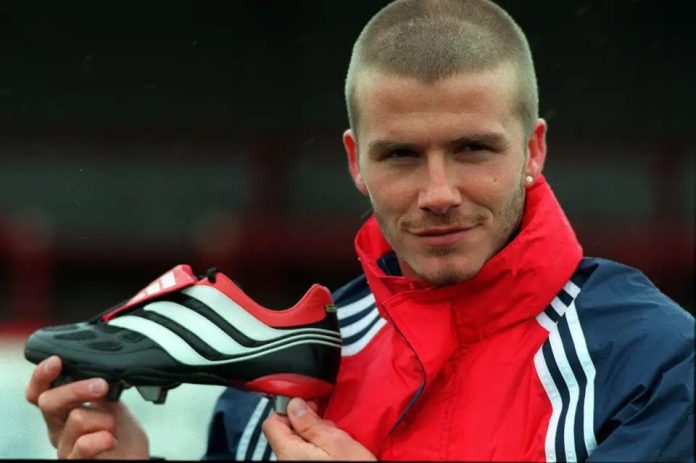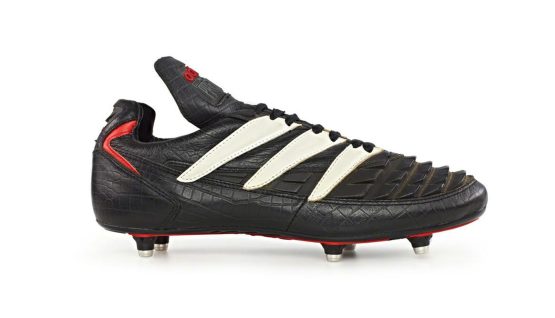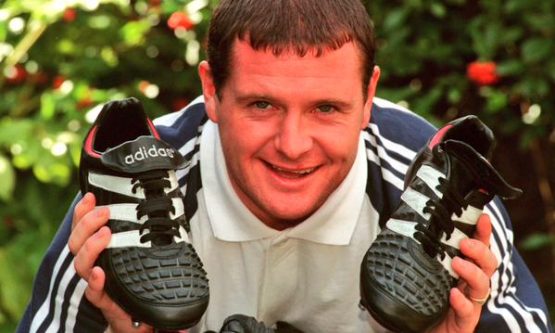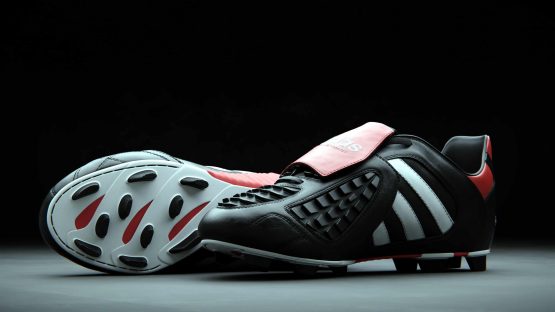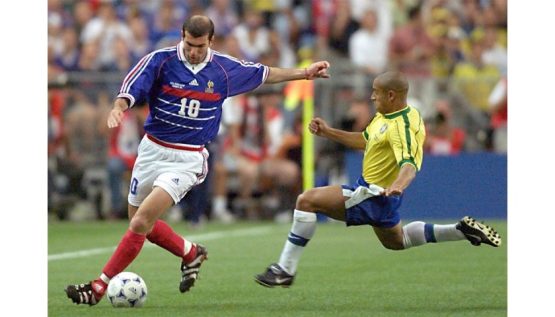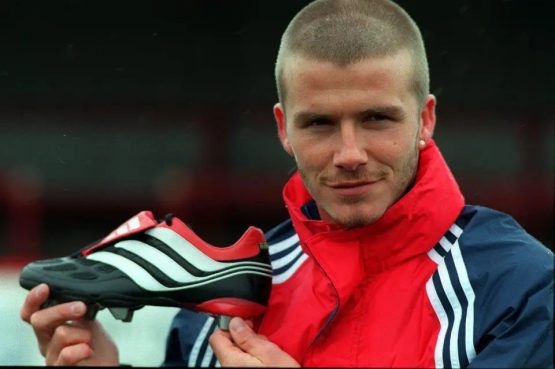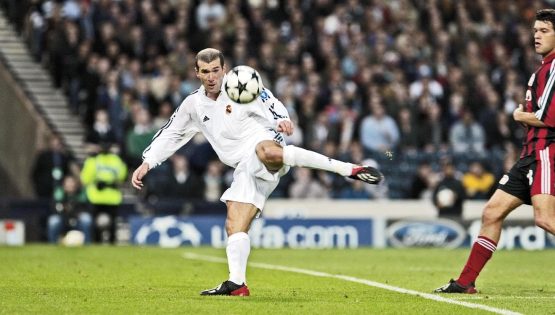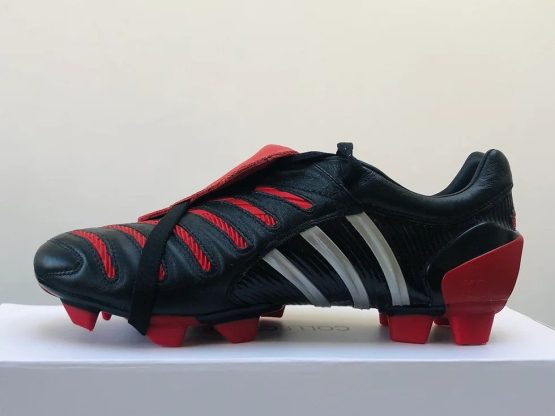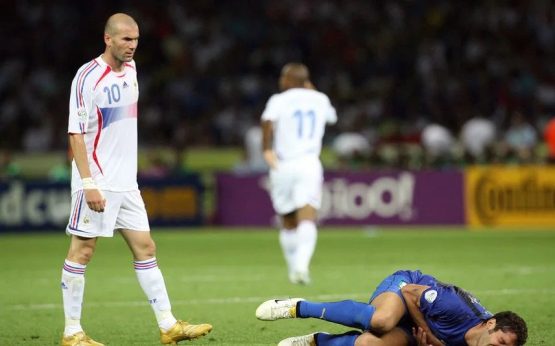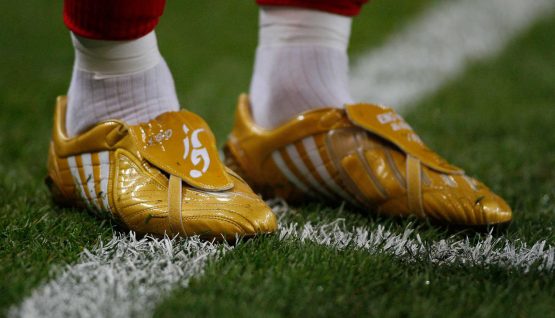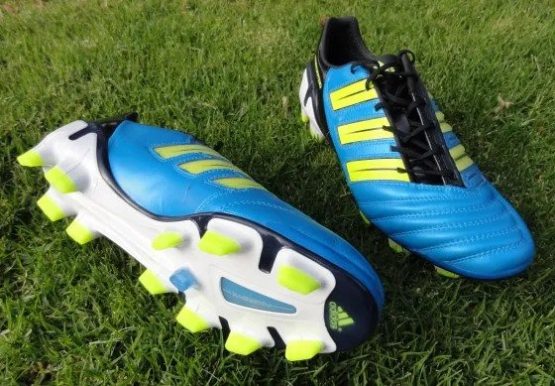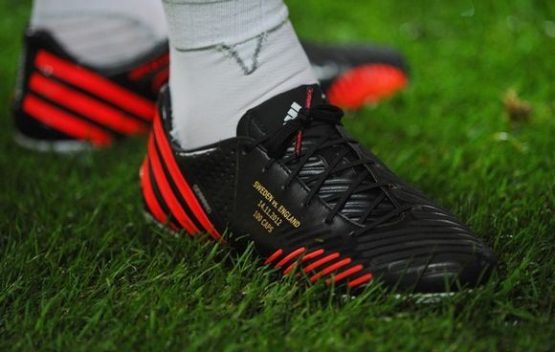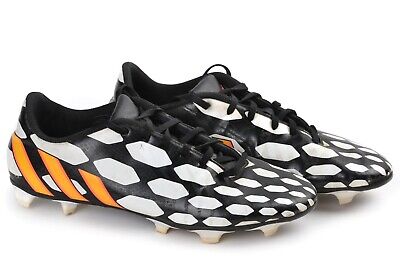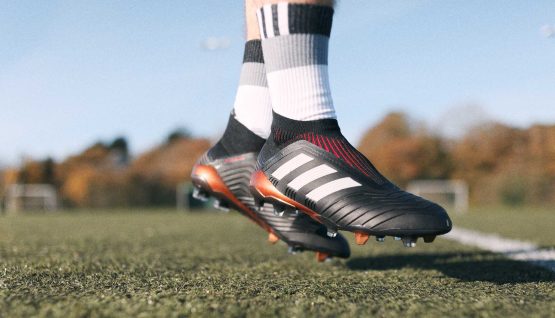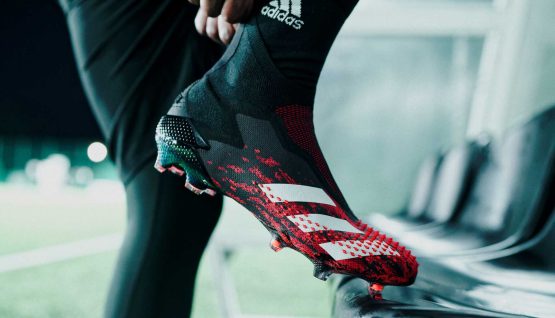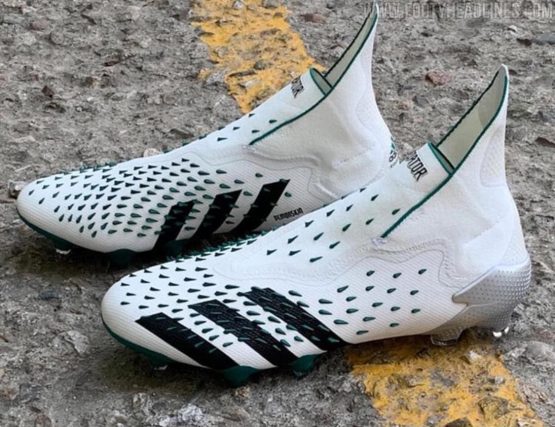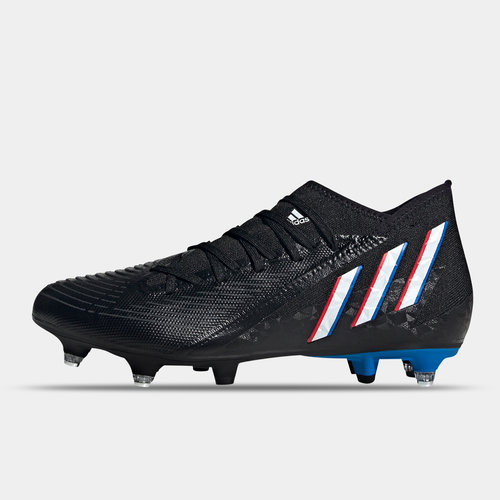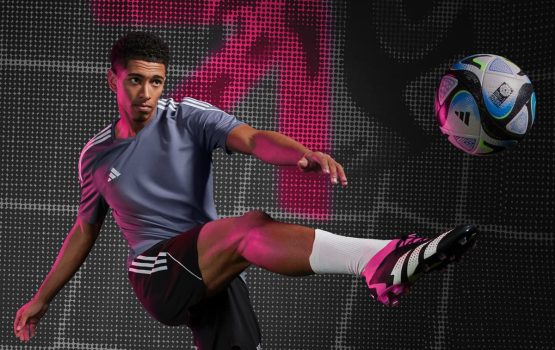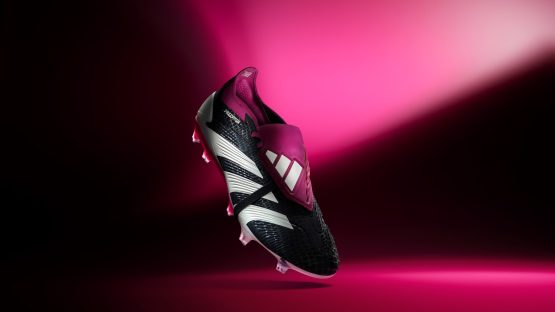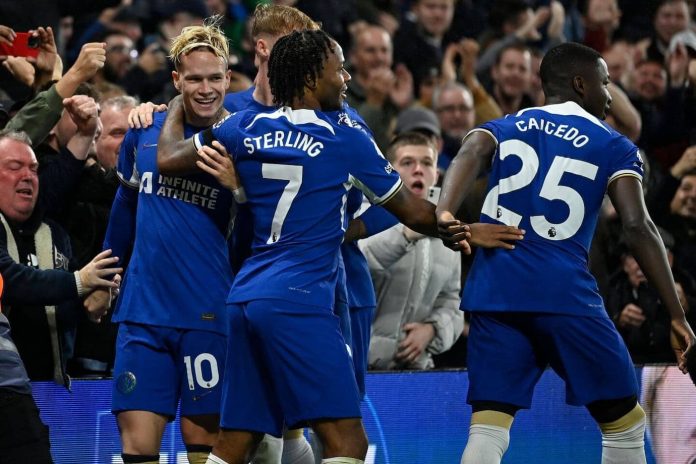As the likes of Trent Alexander-Arnold and Jude Bellingham continue to be spotted sporting the new wave of Adidas’ famed boot, we take a look back through the archives to put together a complete Adidas Predator history timeline.
Trent Alexander-Arnold ended a long-standing apparel deal with Under Armour, with whom he has been an ambassador since he was a teenager, in favour of a £26 million multi-year partnership with Adidas – making it one of the largest boot deals in football.
The brand were rewarded for their faith, as the Liverpool right-back’s 80th minute equaliser against Manchester Cityon matchday 13 provided the optimal platform for the latest iteration of the iconic Adidas Predator to take centre stage.
With many fans clambering for Adidas boots from an era-gone-by, it appears the brand are looking to revert back to an old-school style. Trent’s unreleased white and red pair boast the iconic foldover tongue, and a design reminiscent of Beckham’s famous Predator Mania’s from the early naughties.
Trent’s new Adidas Next-Gen Predator boots…they seemed to do the trick 🔥 pic.twitter.com/Ef10hpr0PJ
— The Anfield Talk (@TheAnfieldTalk) November 26, 2023
You have to rewind before the turn of the century to find the first ever release of the Predators, so lets take a flick through the archives for a dose of Monday morning nostalgia.
The Complete Adidas Predator History
Predator (1994)
The OG. The one that started it all.
As is customary for anyone and anything iconic, the original Predator boot has its own unique origin story.
Former Liverpool and Middlesbrough midfielder Craig Johnston managed to convince two of Germany’s most legendary figures – Franz Beckenbauer and Karl-Heinz Rummenigge – to play in his newly-designed prototypes.
He came up with the idea of putting ‘fins’ on the front of the boot, although the designs were routinely rejected.
Adidas, however, saw footage of Beckenbauer and Rummenigge flitting about in the snow donning the somewhat garish design, in comparison to the industry standard at the time, and decided to launch a brand new line.
Predator Rapier (1995)
Following on from the success of the first edition, Adidas tweaked the design in order to make the ‘fins’ less rigid.
The upgrade involved putting bumps on the roof on the boot, and it also marked the first Adidas Predator to be readily available in different colours.
The design was also the first to incorporate the foldover tongue, which of course has gone on to become the most iconic feature in subsequent Predator designs.
Enjoy a dose of dopamine below, which pictures a very happy Paul Gascoigne with a brand new pair of Rapier’s in the official release photos.
Predator Touch (1996)
The Predator Touch came equipped with an even more striking overhaul of the ‘fins,’ this time covering the entire instep area including the inner toe for supposed ‘greater control.’
Whether this ‘control’ feature is a marketing gimmick or backed up by real science need not be determined – I’m still going to buy them regardless.
We simply can’t skip past these without mentioning that Gascoigne goal against Scotland at Euro ’96, much of which can be attributed to the boot itself after he admitted he scuffed the shot off the end of his toe.
Predator Accelerator (1998)
The first two-year hiatus from Adidas since launching the Predator line saw them strip the boot back in favour of a lighter, more agile model.
The 1998 World Cup in France proved the ultimate stage for the Accelerators to cement themselves as one of the finest boots Adidas have ever made. Arguably the cleanest, sleekest iteration of the Predator line, it is no wonder these have been re-released an inordinate amount.
The unmistakable sight of eventual World Cup winner Zinedine Zidane – who still had hair at this point – gracefully scampering around the pitch against Brazil in the final conjures up a feeling that is hard to put into words.
Predator Precision (2000)
The turn of the century saw Adidas opt for a design befitting of the 2000’s, which involved making the red and white accents curvier.
The new futuristic model was also complimented by the first ever set of replaceable studs to well and truly welcome in the 21st century, although players would often leave the field with less studs than they entered it.
The technology would eventually catch up, but these utterly gorgeous boots had some iconic moments of their own, including being the vehicle with which David Beckham sent an unerring free-kick into the top corner against Greece in 2002, to secure last-gasp spot at the World Cup.
Predator Mania (2002)
Phwoar. Probably the best of the lot, and undoubtedly many people’s favourite boot of all time.
Adidas ditched the ‘fins’ and control panels in favour of an all-over padded leather, while the now-iconic tongue came with a band that wrapped underneath and around, instead of a flimsy patch of velcro on the older models.
Adidas also moved the laces slightly off centre for a greater surface area on the toes, which had rubber panels in the form of the brand’s iconic three white stripes.
Released ahead of the World Cup in ’02, these were absolutely huge at the time. The red, white and black pair is of course the prevailing colourway, but the champagne edition that Beckham donned remain a fan favourite.
Zidane is back on the list again after scoring in the Champions League final in pair of these – hazard a guess which goal? Yep, THAT sweeping volley at Hampden Park.
Predator Pulse (2004)
Following on from the Manias was always going to the prove an uphill battle, and although they didn’t quite live up to the billing of its predecessor, the Pulse model still has that nostalgic, early naughties feel.
Keeping the popular tongue band, Adidas added the PowerPulse System, which was essentially a sockliner for added grip and control.
Predator Absolute (2006)
There were plenty of iconic moments for the Absolute model, but none more so than Zinedine Zidane’s final curtain call at the World Cup that year.
After coming out of international retirement and dominating the likes of Brazil and Portugal on the way to the final, lifting the World Cup seemed almost inevitable against an inferior Italy side – one last hurrah for the game’s greatest midfielder.
Instead, Zidane managed to outshine the gleaming, garish all-gold Predator Absolutes after launching a headbutt to the chest of Marco Materazzi.
An astonishing closing chapter that only adds to the enigma that is Zidane. The iconic picture of him stepping off the pitch in those special edition Absolutes while staring down the biggest prize in football is the stuff of myth and legend.
Predator PowerSwerve (2007)
2007’s release marked the final time the Predators came with a foldover tongue, although one can hope the pair Trent donned against Manchester City will be released to the public.
These were developed with the help of recently retired Zidane, and came with a boatload of science. The new SmartFoam, which replaced the old rubber, was said to achieve 8% more swerve and increase the power behind every shot by around 3%.
Predator X (2009)
The X’s felt like the natural evolution from its predecessor, but in doing so Adidas ditched pretty much every detail that made the classic Predators so sought after.
The tongue was removed, so too the kangaroo leather in favour of Tarus leather, which is said to have made these feel largely uncomfortable and unforgiving on your feet.
They remain perhaps the last vestige of that iconic Predator look however, and we can’t help but reminisce of Spain lifting the World Cup in 2010 with Barcelona’s midfield three all donning these.
Predator AdiPower (2011)
We would be lying if we said we liked these.
At the turn of the decade these Predators were released, mirroring the general forgettable fashion trends of the early 2010’s.
In favour of a considerably lighter design, the AdiPowers were a reflection of what was popular amongst consumers at the time, with football’s leading two manufacturers – Adidas and Nike – releasing boots that promised a ‘closer feel’ of the ball.
By this time, Adidas’s F50 was their most popular release, and these Predators are, by all accounts, pretty meh.
Predator Lethal Zones (2012)
Again, a design that will have the vast majority of football purists scrunching their noses, but still closer to the older models than the AdiPowers.
A newer, more synthetic material was introduced to make the Lethal Zones, or ‘Lz’s’, as light as possible. Adidas did opt to bring back the controls panels that were absent from the AdiPowers, but nothing like the ones of the older models.
Predator Instinct (2014)
2014’s edition, dubbed the Predator Instinct, is about as far away from the original 1990’s models as Adidas dared to venture.
In-keeping with the wider consensus that lighter models sell the best, these were essentially F50’s with a few classic Predator elements, such as the three stripes down the side.
Angel Di Maria managed to make this unpalatable pair slightly more digestible after singlehandedly dragging Real Madrid to ‘La Decima’ in the 2014 Champions League final, but these are largely forgotten.
Predator 18 (2017)
Adidas decided to drop the Predator line to focus on their best sellers following the Instinct, signalling a three-year gap before the next release.
Luckily for loyal Predator fans, they returned with a glorious design in 2017 that was very much rooted in contemporary models, but with that classic, retro Predator feel from the mid-to-late 90’s.
The first Predator to feature a laceless upper, the stretchy Primeknit material made for a grip-like fit that almost felt as if you were wearing a sock. Although futuristic in every sense, Adidas drew classic elements from the original designs, including discernible control panels that tickle at the nostalgia of the ‘fins’ from 1994’s original model.
Predator Mutator (2020)
Almost four years old already? Wow.
These caused quite the stir upon release, but the prevailing consensus is these are one of the better modern boots Adidas have made in recent years.
They took the ‘teeth’ idea of the 1990’s and ran wild with it, installing over 400 rubber bumps all over the fully Primeknit upper for absolute control of the ball. They look like some sort of extra-terrestrial creature, and we love it.
While the Predator 18 ushered in the beginnings of the modern Predator, the Mutator took it to a whole new level.
Predator Freak (2021)
Pretty similar to the Mutator, but with a few facelifts. Not least splitting the ‘sock’ part into two sections for an even cosier grip on the heel, and greater dexterity for forward motions.
Predator Edge (2022)
A World Cup year has often proved a pivotal time for Predator releases, and 2022’s edition was notable overhaul from the ultra-modern, sock-like designs of late.
The Edge replaced the alien-like spikes in favour of a sleeker, classic exterior. It is perhaps the closest thing to the original design since the X in 2009.
Predator Accuracy (2023)
We’ve gotta say Adidas really knocked it out the park with these, they are stunning. Most likely due to their likeness to the 1998 Accelerators, with the bold three white stripes covering the majority of the outermost edge.
The 3D rubber bumps make a return, although in far less numbers than the Mutator and Freak models, while the Hybridtouch exterior is made of 50% recycled material.
Undoubtedly one of the best in Adidas Predator history given the hit and misses of the contemporary designs.
Predator 30 (2023)
The newest release of Adidas predators until (very) recently is the ‘Predator 30’ which has caught the eye of football fans across the world.
Only 1994 have been released, with the boot showing several nostalgic call-backs including the infamous fold-over tongue.
Jude Bellingham and Trent Alexander-Arnold have been seen rocking the new boots, as Adidas continues to showcase the top talent in football.
Predator 24 (2024)
Akin to to the Predator 30, Adidas’ newest model – dubbed the Predator 24 – is again similar in design to the ’98 accelerators.
Adidas appear to have struck gold with these, finding the equilibrium between retro nostalgia and modern innovation. The splash of neon yellow is an eye-catching addition to the traditional black, red and white – the DNA that makes a Predator a Predator.
Unlike the limited release of its predecessor, they are available for public release on the Adidas website, although they are all but sold out at the time of writing bar a few sizes.
Add Sportslens to your Google News Feed!
